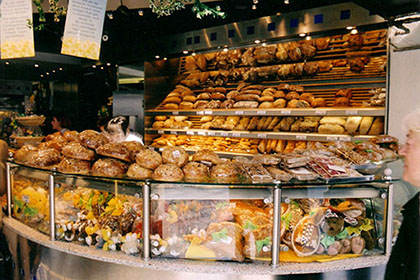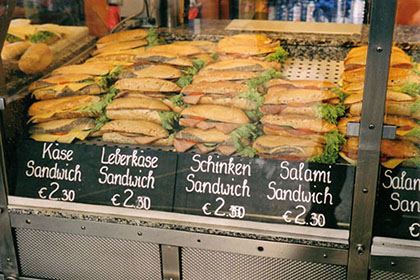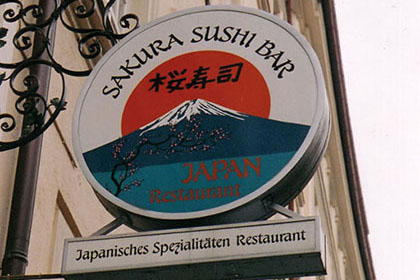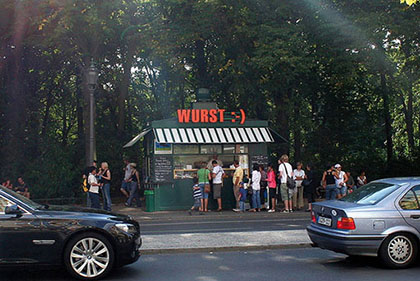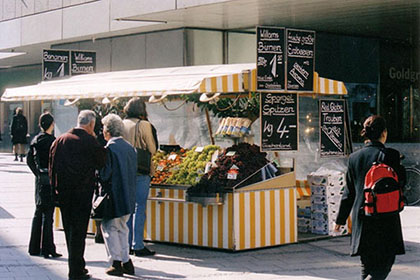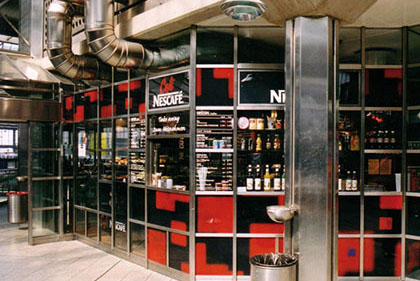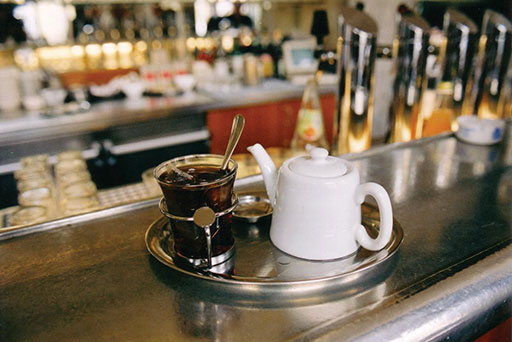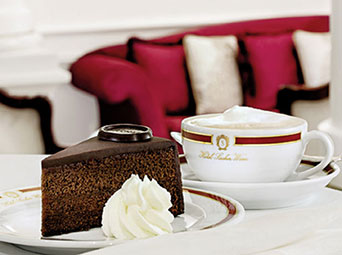4 Where to eat
Culture: Meals and snacks in German-speaking countries
The three main meals (Hauptmahlzeiten) are das Frühstück, das Mittagessen and das Abendessen. Although some working patterns make it more convenient to have a hot meal in the evening, traditionally the main cooked meal in Germany, Austria and Switzerland is taken at lunchtime, with the evening meal often consisting of bread with a selection of cheeses, cold cooked meats and salads, hence the alternative name of das Abendbrot.
There are many different regional names for snack times between meals (Zwischenmahlzeiten). These include die Brotzeit in Bavaria, die Jause in Austria and das z’Nüni in Switzerland.
In many parts of Germany there is a tradition known as der Frühschoppen, where locals get together in a bar or inn (das Wirtshaus) after church on a Sunday morning for a chat over a glass of beer or wine. As regular customers, they will often have a table (der Stammtisch) which is always reserved for them.
Activity 12
You can buy food and drink in many different places. Match photos 1–6 to the descriptions beneath.
Two lists follow, match one item from the first with one item from the second. Each item can only be matched once. There are 6 items in each list.
Photo 3
Photo 6
Photo 4
Photo 2
Photo 5
Photo 1
Match each of the previous list items with an item from the following list:
a.Hier kann man Brot kaufen.
b.Hier kann man Bratwurst kaufen.
c.Hier kann man japanisch essen.
d.Hier kann man Kaffee trinken.
e.Hier kann man Obst und Gemüse kaufen.
f.Hier kann man ein Schinkenbrötchen kaufen.
- 1 = c,
- 2 = d,
- 3 = b,
- 4 = f,
- 5 = e,
- 6 = a
Language: Making generalisations using man
Man is often translated into English as ‘one’. When you are talking about people in general in English, you might say ‘you’, ‘they’ or ‘people’ rather than the formal-sounding ‘one’, but man doesn’t have the same formal ring to it in German. Compare the following sentences, for example:
Was isst man hier? | What do people eat here? / What do they eat here? |
To talk about what is on offer at certain places, you can combine man with kann:
Was kann man hier trinken? | What can you drink here? (lit. ‘What can one drink here?’) |
The verb used with man takes the same verb form as with er/sie/es (e.g. man isst, man kann).
Activity 13
a.
die Bar (-s)
b.
das Café (-s)
c.
das Gasthaus (die Gasthäuser)
d.
der Gasthof (die Gasthöfe)
e.
die Gaststätte (-n)
f.
das Hotel (-s)
g.
die Imbissstube (-n)
h.
die Kneipe (-n)
i.
das Lokal (-e)
j.
das Restaurant (-s)
The correct answers are a, b, c, f, i and j.
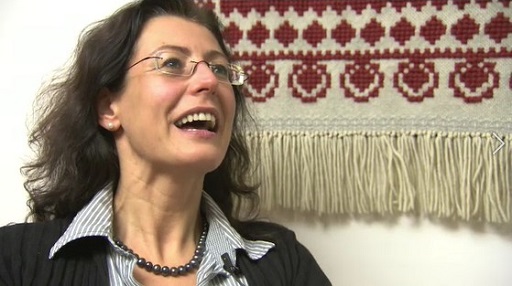
Transcript: Video 1
Activity 14
a.
chinesisch
b.
deutsch
c.
französisch
d.
griechisch
e.
indisch
f.
italienisch
g.
österreichisch
h.
spanisch
i.
thailändisch
The correct answers are a, d, e, f and i.

Transcript: Video 1 (repeated)
Language: Saying what you would like
You may be asked Möchten Sie …? (Would you like …?) to establish what you would like. To respond, use the verb form ich möchte (I would like) or wir möchten (we would like).
Möchten Sie etwas zu essen bestellen? Would you like to order something to eat?
As you listen to these expressions in the recordings, pay particular attention to the ö and ch sounds and try to copy them.
- Vokabeln
- bestellt etwas zu essen orders something to eat
Activity 15
Read the introduction to the recording below and then listen to the conversation between Thomas and a waitress. Then match the German and English phrases underneath – if you don't know all the words, try to work out the meanings from the context.
Thomas und Heike sitzen im Café. Thomas bestellt etwas zu essen und zu trinken.
Transcript: Audio 11
Hören Sie bitte.
Two lists follow, match one item from the first with one item from the second. Each item can only be matched once. There are 8 items in each list.
Excuse me!
we’d like
a pot of coffee
a glass of tea
with lemon
with cream
Anything else?
two pieces of apple cake
Match each of the previous list items with an item from the following list:
a.mit Sahne
b.ein Kännchen Kaffee
c.ein Glas Tee
d.Sonst noch etwas?
e.wir möchten
f.Entschuldigung!
g.mit Zitrone
h.zwei Stück Apfelkuchen
- 1 = f,
- 2 = e,
- 3 = b,
- 4 = c,
- 5 = g,
- 6 = a,
- 7 = d,
- 8 = h
Culture: Kaffee und Kuchen
Having coffee and cakes (Kaffee und Kuchen) with friends in a café or at home is a very popular way to take a late afternoon break in German-speaking countries. Some cafés specialise in what could be called the fourth meal of the day, serving coffee and a range of delicious cakes, such as cheesecake (Käsekuchen) or Austrian chocolate cake (Sachertorte). When visiting friends in the afternoon you may be offered a cup of coffee (eine Tasse Kaffee) and a piece of cake (ein Stück Kuchen). Notice that in these expressions there is no German equivalent for the English ‘of’.

